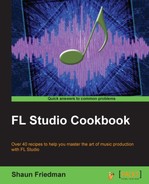In this chapter, we will cover the following topics:
- Using patterns to build a song
- Comparing patterns and audio
- Using markers and snap
- Viewing the playlist
By pasting patterns in FL Studio, you can arrange the many pieces and parts of your production. You may also paint automation curves and record external audio in the playlist. Automation will be covered in Chapter 10, Recording Automation and in the Recording external audio –keyboards, vocals, guitars, turntables, and devics recipe in Chapter 6, Using the FL Studio Mixer and Recording Audio. The playlist is where you can specify which patterns are played (or not played) at which point in time. As discussed previously, you can actually make a full-length song with one pattern by using the Piano roll and by continually adding more beats and bars with data. Thus, beats per bars is the area where you can distinguish between an intro, verse, chorus, bridge, outro, or any type of section of your song. It is all up to the individual artist using FL Studio to decide their particular musical arrangement. This is shown in the first recipe Using patterns to build a song.
You must use patterns that were made in the FL Studio step sequencer in order to build an original musical production from scratch. In this way, you build, overdub, and continually layer in order to come up with an original work. You may also insert full-length WAV or MP3 files and function exclusively as a recording studio, where you would then record vocals on top of the completed instrumental. You can chop any type of material (patterns or audio) in the playlist. So, in the end it may be a true fusion, mixture, and mash up of digital music. All files exist as channels, as reviewed in Chapter 3, Working with the Step Sequencer and Channels.
